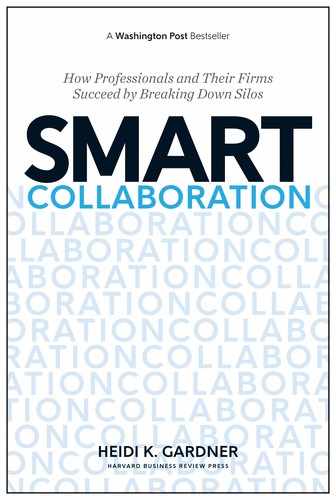68SMART COLLABORATION
Our alumni number nearly 30,000 and work in vir-
tually every business, public, and social sector in 120
countries. Through formal events and informal network-
ing, former McKinsey consultants make and sustain
professional relationships. For those alumni who are inter-
ested, we regularly communicate via e-mail, bi-monthly
webcasts, LinkedIn, and surveys through the McKinsey
alumni website. This dynamic network is a lasting benefit
of a McKinsey career.
30
The accounting firm of PwC counts more than a hundred
thousand former employees in its alumni network, and the firm
reaps many benefits from staying connected with them. First, its
communities of practice—which include alumni—help the firm
identify new trends and connect with potential clients. Second,
PwC has created a new class of what might be called “semi-
alumni”—that is, people who no longer work full time with the
firm, but return to work for short stints during especially busy
periods.
The prescriptive point here is to make sure that people feel
enough affinity with the firm while they’re with you that after they
leave, they remain eager to share expertise, contacts, and other
resources. Collaboration helps instill this perspective: if they have
been part of a strong, collaborative team, then that kind of identi-
fication can be enduring. However, it probably lasts only if a few
other essential factors are in place:
•
Clarify expectations. If you have an up-or-out promotion
system, make it clear from the moment you start recruiting
that most people don’t make partner.
31
• Keep people informed with honest feedback about their
progression.
When it becomes evident that they’re not on
track, give them a choice (if possible): “Up your game to
these specific standards by showing improvement in these
specific ways, or start looking for another place.” Feedback
should never be a surprise.
Chapter_02.indd 68 05/10/16 11:38 pm
The People Case for Collaboration69
• Keep communications positive but realistic. McKinsey has a
clear mantra that even people who don’t succeed at the firm
are still “winners,” but that they need to find a place where
they can leverage their skills better or thrive in a different
environment.
•
Give people time to search for the next opportunity,
and help them find positions that fit their skills.
Firms
find it mutually beneficial to place leavers with exist-
ing or desired clients, but the sophisticated ones know
that having employees leave on good terms is the most
important aspect.
•
Allow the person who’s leaving to control the message. At
McKinsey, most people left for “an exciting new opportu-
nity.” Except to a few close friends, perhaps, it was never
clear whether leaving had been their choice or whether they
were managed out. And it didn’t matter, because by the time
they left, they really did have a great place to land.
Those five steps are critical for helping to translate the positive
experience people had while collaborating as your employees into
lasting relationships after they leave your firm. Chances are also
good that if your firm’s culture and talent management systems are
robust enough to support this sort of alumni-building program,
they will also help to foster collaboration before people consider
leaving.
Moving to the other side of the table
Here’s a key takeaway from this chapter: collaboration doesn’t
just make people feel as if they are in the right place. In fact, it’s
a self-fulfilling prophecy. Collaboration makes the “fit” better,
makes the hard work more efficient and effective, and thereby
makes the firm more successful.
The many specifics in this chapter—the how to’s—may lead the
reader to believe that embracing collaboration is little more than
Chapter_02.indd 69 05/10/16 11:38 pm
70SMART COLLABORATION
a thinly disguised strategy for getting more work out of people.
Far from it! Collaboration can be inspirational, motivational, and
even joyful. A management consultant recently told me about his
experience pitching new business. He had teamed up with a fellow
partner, and the two of them made it their mission to go after some
very high-profile potential clients in faraway parts of Australia. He
said that he had the courage and fortitude to do this only because
he had teamed up with somebody—together they felt braver, and
had a much higher risk tolerance. “It certainly didn’t always work,”
he said, smiling at the recollection, “but even when it didn’t, she
and I always ended up at the pub, laughing it off over a couple of
beers. Whereas if I had suffered that same rejection on my own, I
for sure wouldn’t have gone to the next pitch.”
This is a good preamble to the chapters that follow. The chapters
thus far have adopted the firm perspective: Why should the firm
worry about and invest in collaboration? The next four chapters
look at the same question from the other side of the table: Why
should key individuals within the firm bet on, and invest in, a col-
laborative approach?
We start in chapter 3 with what I call solo experts: those individ-
uals who have already demonstrated their worth, are reasonably
confident in their ability to sell as many hours as they want based
on their own expertise, and need to be persuaded that collabora-
tion will open new opportunities for them.
Chapter_02.indd 70 05/10/16 11:38 pm
..................Content has been hidden....................
You can't read the all page of ebook, please click here login for view all page.
